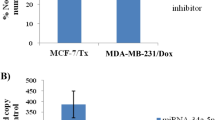Summary
The purpose of this paper is to investigate the reversal effect of small interfering RNA (siRNA) targeting MDR1 and MDR3 genes on the resistance of MCF-7/ADR cells to adriamycin. siRNA plasmid vector targeting MDR1 and MDR3 genes was transfected into MCF-7/ADR cells, and then was stained with Annexin-V FITC (fluorescein isothiocyanate conjugated) to detect the early stage cell apoptosis by flow cytometry (FCM). 50 % inhibition concentration (IC50) of adriamycin for MCF-7/ADR cells was determined by MTT method. MDR1 and MDR3 mRNA was assessed by RT-PCR. Treatment of MCF-7/ADR cells with the two kinds of siRNAs resulted in a reversal of adriamycin resistance of MDR to different extents. 1) The apoptosis efficiency of MDR1 and MDR3 siRNA vector after transfection was (18.21 ± 1.65) % and (9.07 ± 2.16) % respectively (P<0.05), and there was significant differences in the apoptosis efficiency between pSuppressor Neo vector and the MDR1siRNA or MDR3 siRNA vector (P<0.01); 2) The reversal effect of MDR1siRNA is higher than that of MDR3 siRNA (P<0.05); 3) The expression of MDR1 and MDR3 mRNA can be restrained by pSuppressor Neo MDR1 and MDR3 siRNA respectively, and the reduction in the mRNA level was in a time-dependent manner (P<0.01). MDR1 and MDR3 gene silencing can enhance intracellular adriamycin accumulation in MCF-7/ADR cells, improve sensitivity of MCF-7/ADR cells to adriamycin, and induce cell apoptosis. The reversal effect of adriamycin resistance by siRNA of MDR1 was more effective than that of MDR3.
Similar content being viewed by others
References
Labroille G, Belloc F, Bilhou-Nabera C et al. Cytometric study of intracellular p-gp expression and reversal of drug resistance. Cytometry, 1998,32(2):86–94
Liu R, Hsieh C Y, Lam K S. New approaches in identifying drugs to inactivate oncogene products. Semin Cancer Biol, 2004,14:13–21
Johnson D R, Finch R A, Lin Z P et al. The pharmacological phenotype of combined multi-drug resistance mdr1a/1b2 and mrp1-deficient mice. Cancer Res, 2001,61(4):1469–14761
Smith AJ, Van Meer G, Van Helvort A et al. MDR3 P-glycoprotein, a phosphatidyl-choline translocase, transports several cytotoxic drugs and directly interacts with drugs as judged by interference with nucleotide trapping. J Biol Chem, 2000,275(31):23530–23539
Xu D, Ye D, Fisher M et al. Selective inhibition of P-glycoprotein expression in multidrug resistant tumor cells by a designed transcriptional regulator. J Pharmacol Exp Ther, 2002,302:963–971
Sunita G, Rebecca A S, James E E et al. Inducible,reversible, and stable RNA interference in mammalian cells. Proc Natl Acad Sci USA, 2004,101:1927–1932
Yague E, Higgins C F, Raguz S. Complete reversal of multidrug resistance by stable expression of small interfering RNAs targeting MDR1. Gene Ther, 2004,11:1170–1174
Thomas H, Coley HM. Overcoming multidrug resistance in cancer: An update on the clinical strategy of inhibiting P-glycoprotein. Cancer Control, 2003,10(2):159–165
Barraud L, Merle P, Soma E et al. Increase of doxorubicin sensitivity by doxorubicin-loading into nanoparticles for hepatocellular carcinoma cells in vitro and in vivo. J Hepatology, 2005,(42)736–743
Author information
Authors and Affiliations
Rights and permissions
About this article
Cite this article
Xiao, L., Gao, R., Lu, S. et al. Reversal of adriamycin resistance in human mammary cancer cells by small interfering RNA of MDR1 and MDR3 genes. J. Huazhong Univ. Sc. Technol. 26, 735–737 (2006). https://doi.org/10.1007/s11596-006-0630-4
Received:
Issue Date:
DOI: https://doi.org/10.1007/s11596-006-0630-4




